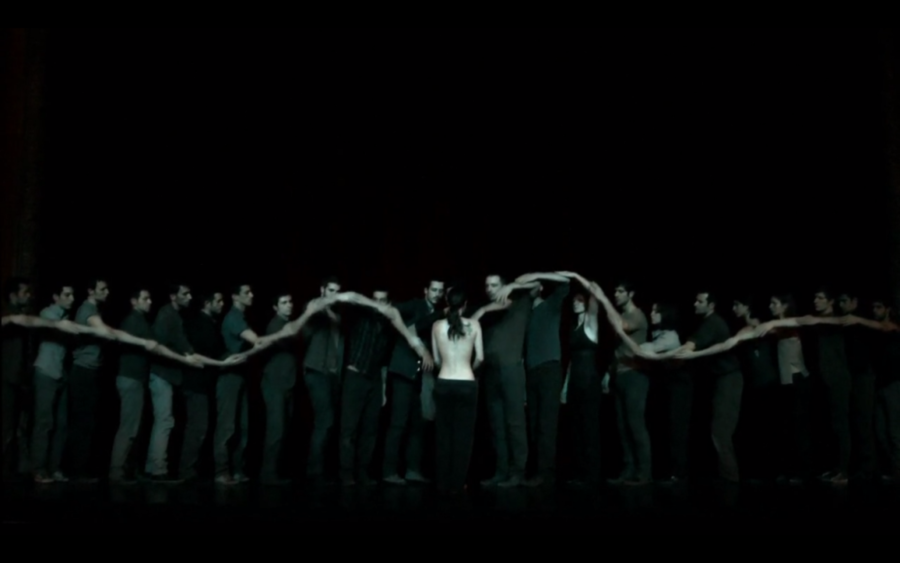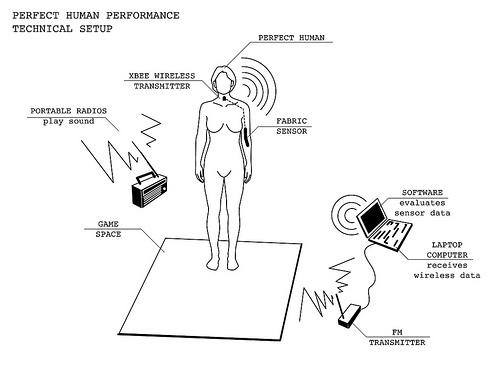Difference between revisions of "/inspiration"
| Line 43: | Line 43: | ||
[[File:Schermafbeelding 2014-11-26 om 12.39.58.png | 500px]] | [[File:Schermafbeelding 2014-11-26 om 12.39.58.png | 500px]] | ||
| + | |||
| + | Groupe de Recherche d’Art Visuel (GRAV) (Research Art Group) was a collaborative artists group in Paris[1] that consisted of eleven opto-kinetic artists, like François Morellet, Julio Le Parc, Francisco Sobrino, Horacio Garcia Rossi, Yvaral, Joël Stein and Vera Molnár, who picked up on Victor Vasarely's concept that the sole artist was outdated and which, according to its 1963 manifesto, appealed to the direct participation of the public with an influence on its behavior, notably through the use of interactive labyrinths. | ||
| + | GRAV was active in Paris from 1960 to 1968.[2] Their main aim was to merge the individual identities of the members into a collective and individually anonymous activity linked to the scientific and technological disciplines based around collective events called Labyrinths. | ||
| + | Their ideals enticed them to investigate a wide spectrum of kinetic art and op art optical effects by using various types of artificial light and mechanical movement. In their first Labyrinth, held in 1963 at the Paris Biennale, they presented three years work based on optical and kinetic devices. Thereafter they discovered that their effort to engage the human eye had shifted their concerns towards those of spectator participation; a foreshadow of interactivity. | ||
| + | On April 19, 1966 GRAV created Une Journée dans la rue (Day in the Street) in Paris where they invited passing participants to involve themselves in various kinetic activities such as having them walk on uneven blocks of wood and/or experience a distorted world by wearing elaborate distorting spectacles. | ||
| + | Their agreed dissolution in November 1968 was based on their recognition that it was impossible to maintain the rigor of a joint program. | ||
Revision as of 11:56, 15 January 2015
INSPIRATION:
Amazing dance!!!
NOWHERE explores the nature of the theatrical stage itself, a spatial mechanism continually transformed and redefined by the human presence to denote any place, and yet designed to be a non-place. 26 performers measure and mark out the space using their bodies, pitting themselves against its dimensions and technical capabilities in a site-specific performance that can be presented nowhere else.
PERFECT HUMAN 2008 Inspired by Joergen Leth’s 1967 short film “The Perfect Human” and Lars von Trier’s “The Five Obstructions” (2003). This performance intends to create a sixth obstruction of The Perfect Human, by introducing rules in order to complete the performance as a game.
In preparation for the game the performer receives a suitcase, one week in advance. The artists do not meet or talk with the performer until the day of the performance. The Suitcase contains items selected to help the performer prepare herself for the game. None of the items impose any obligation on the performer. Instead she is free to inspect and make use of them in any way she sees fit. But she must prepare herself. On the day of the performance, the performer must show up at the named time and location carrying the suitcase with all its contents. The game begins as the performer starts putting on the socks, the last item of the costume.
During the performance the performer reaches a point in the game, where she must mirror the audience in order to complete the level. This allows the audience to explore the wearable motion-capture system through the mirroring of movement. Moreover the audience must themselves become involved in order to perform the role of the perfect human
Technical The actual performance takes place in public space. The setup is fully portable by the artists and performer. The performer wears a handmade motion-capture costume that includes fabric bend sensors for tracking the motion of the limbs and wireless communication to send the sensor data from the suit to a nearby laptop. Software on the laptop analyzes the sensor data and triggers words from The Perfect Human text. An FM radio transmitter broadcasts these words to surrounding radios, which are tuned to the frequency of the FM transmitter. The radios play back the sound for everybody to hear.
The Hug Shirt!
Is a shirt that makes people send hugs over distance!
The HugShirt was invented by Francesca Rosella and Ryan Genz the co-founders of CuteCircuit, the London based award-winning design company.
The Hug Shirt Embedded in the shirt there are sensors that feel the strength of the touch, the skin warmth and the heartbeat rate of the sender and actuators that recreate the sensation of touch, warmth and emotion of the hug to the shirt of the distant loved one.
The Hug Shirt™ has been awarded as one of the Best Inventions of the Year by Time Magazine.
The Hug Shirt™ is a Bluetooth accessory for Java enabled mobile phones. Hug Shirt™s don’t have any assigned phone number, all the data goes from the sensors Bluetooth to your mobile.
phone and your mobile phone delivers the hug data to your friend’s phone and it is seamlessly transmitted Bluetooth to his or her shirt!Sending hugs is as easy as sending an SMS and you will be able to send hugs while you are on the move, in the same way and to the same places you are able to make phone calls (Rome to Tokyo, New York to Paris).
The Hug Shirt in Brazil The system is very simple: a Hug Shirt™ (Bluetooth with sensors and actuators), a Bluetooth java enabled mobile phone with the HugMe™ java software running (it understands what the sensors are communicating), and on the other side another phone and another shirt. If you do not have a Hug Shirt™ but know that your friend has one you can still send them a hug creating it with the HugMe™ software and it will be delivered to your friend’s Hug Shirt.
Groupe de Recherche d’Art Visuel (GRAV) (Research Art Group) was a collaborative artists group in Paris[1] that consisted of eleven opto-kinetic artists, like François Morellet, Julio Le Parc, Francisco Sobrino, Horacio Garcia Rossi, Yvaral, Joël Stein and Vera Molnár, who picked up on Victor Vasarely's concept that the sole artist was outdated and which, according to its 1963 manifesto, appealed to the direct participation of the public with an influence on its behavior, notably through the use of interactive labyrinths. GRAV was active in Paris from 1960 to 1968.[2] Their main aim was to merge the individual identities of the members into a collective and individually anonymous activity linked to the scientific and technological disciplines based around collective events called Labyrinths. Their ideals enticed them to investigate a wide spectrum of kinetic art and op art optical effects by using various types of artificial light and mechanical movement. In their first Labyrinth, held in 1963 at the Paris Biennale, they presented three years work based on optical and kinetic devices. Thereafter they discovered that their effort to engage the human eye had shifted their concerns towards those of spectator participation; a foreshadow of interactivity. On April 19, 1966 GRAV created Une Journée dans la rue (Day in the Street) in Paris where they invited passing participants to involve themselves in various kinetic activities such as having them walk on uneven blocks of wood and/or experience a distorted world by wearing elaborate distorting spectacles. Their agreed dissolution in November 1968 was based on their recognition that it was impossible to maintain the rigor of a joint program.



